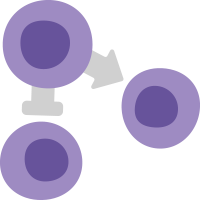
Immune Regulation News
Immune Regulation News is an online resource covering research into the regulation, suppression, and modulation of the immune system.
Antisense to Human CD39 Dysregulates Immune Metabolism in Inflammatory Bowel Disease
[Cellular & Molecular Immunology] Researchers investigated how CD39-AS affects the function of Tregs and Th17 cells in healthy subjects and inflammatory bowel disease patients.
Bat Organoids Reveal Antiviral Responses at Epithelial Surfaces
[Nature Immunology] The authors developed respiratory and intestinal organoids that recapitulate the cellular diversity of the in vivo epithelium present in Rousettus aegyptiacus, the natural reservoir for the highly pathogenic Marburg virus.
Establishment of Salivary Tissue-Organoid Biorepository: Characterizing Salivary Gland Stem/Progenitor Cells and Novel Differentiation Marker PSMA/FOLH1
[npj Regenerative Medicine] The authors established the first diverse and clinically annotated salivary regenerative biobank at Mayo Clinic to study salivary gland stem/progenitor cells.
Microfluidic Bioprinting As a Tool to Produce hiPSCs-Derived Renal Organoids
[Biofabrication] Investigators established differentiation protocols to obtain hiPSC-derived metanephric mesenchyme, ureteric bud progenitors, and the com-bination of these was used to form organoids.
Modeling Hereditary Diffuse Leukoencephalopathy with Axonal Spheroids Using Microglia-Sufficient Brain Organoids
[Elife] Investigators used a macrophage and forebrain organoid co-culture system based on iPSCs generated from two patients with hereditary diffuse leukoencephalopathy with axonal spheroids, with colony stimulating factor-1 receptor gene-corrected isogenic organoids as controls.
Construction of a Metastasis Model for Liver Cancer Spheroids to Hepatobiliary Organoids Facilitated by Holographic Acoustic Tweezers
[Cell Reports Physical Science] Scientists assessed the biosafety of three-dimensional holographic acoustic fields on organoids and spheroids at the cellular and genetic levels, optimizing the parameters for manipulation.
Glioblastoma-Instructed Astrocytes Suppress Tumor-Specific T Cell Immunity
[Nature] The authors used single-cell and bulk RNA sequencing of clinical glioblastoma samples and samples from preclinical models, multiplexed immunofluorescence, in vivo CRISPR-based cell-specific genetic perturbations and in vitro mouse and human experimental systems to study the role of astrocytes in the immune response to glioblastoma.
Inhibition of ENT1 Relieves Intracellular Adenosine-Mediated T Cell Suppression in Cancer
Researchers showed that adenosine suppresses anti-cancer T cell responses following uptake into activated T cells by equilibrative nucleoside transporter 1 (ENT1) and inhibition of de novo...
A Probiotic Approach Identifies a Treg-Centred Immunoregulation via Modulation of Gut Microbiota Metabolites in People with Multiple Sclerosis and Healthy Individuals
[eBioMedicine] Investigators found a lactobacilli-enriched probiotic that promotes a regulatory immunophenotype in people with multipel sclerosis (MS), probably by enhancing AHR agonists in the gut. It may be of interest as add-on therapy in immune-mediated diseases such as MS.
IDO Can Improve Ovarian Function in Premature Ovarian Insufficiency via AhR and Regulatory T Cells
[Biology of Reproduction] Human ovarian granulosa cells were collected via the density gradient method, pZP3 was used to establish an immune POI mouse model, and an AAV vector carrying indoleamine 2,3-dioxygenase (IDO1) was injected into mouse ovaries to induce IDO overexpression.
Regulatory T Cells Suppress TLR9-Induced Formation of Intrahepatic Myeloid-Cell Aggregates for T Cell Population Expansion in Liver
[Medical Microbiology and Immunology] Scientists investigated whether Tregs are involved in regulating toll-like recepto r9-induced intrahepatic myeloid-cell aggregates for T cell population expansion formation and the mechanisms behind it by using different gene knockout mice and blocking antibodies.
The Paeonol of Total Glucosides of White Peony Regulates the Differentiation of CD4+Treg Cells through the EP300/Foxp3 Axis to Relieve Pulmonary Fibrosis in Mice
[Cell Biochemistry and Function] Researchers investigated whether paeonol could improve pulmonary fibrosis in mice by regulating through the EP300/Foxp3 axis. The ratio of CD4+T/Treg cells was measured in vitro, and immunofluorescence was used to detect the intensity of α-SMA.
For over a decade, Immune Regulation News has been keeping the scientific community up-to-date with the latest research and reviews related to immune regulation. Key research areas covered include the roles of regulatory T cells (Treg cells) in autoimmunity and self-reactivity, as well as immune response to disease, transplantation and cancer. We also provide vital updates on the latest jobs and upcoming events in the field of immunology.

 Cancer Stem Cell News
Cancer Stem Cell News Cell Therapy News
Cell Therapy News Dermal Cell News
Dermal Cell News Endothelial Cell News
Endothelial Cell News ESC & iPSC News
ESC & iPSC News Extracellular Matrix News
Extracellular Matrix News Hematopoiesis News
Hematopoiesis News Hepatic Cell News
Hepatic Cell News Human Immunology News
Human Immunology News Immune Regulation News
Immune Regulation News
 Intestinal Cell News
Intestinal Cell News Mammary Cell News
Mammary Cell News Mesenchymal Cell News
Mesenchymal Cell News Muscle Cell News
Muscle Cell News Neural Cell News
Neural Cell News Organoid News
Organoid News Pancreatic Cell News
Pancreatic Cell News Prostate Cell News
Prostate Cell News Pulmonary Cell News
Pulmonary Cell News
